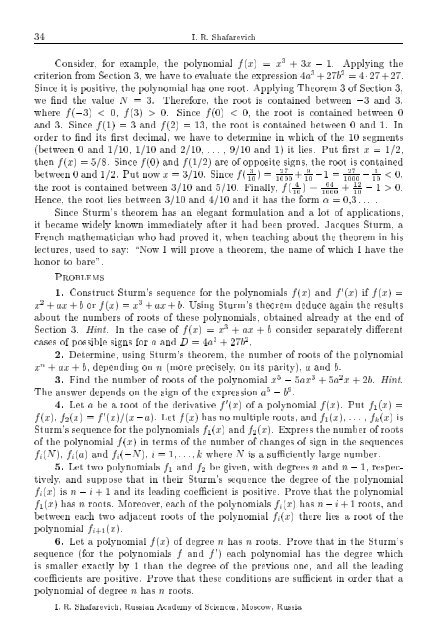SELECTED CHAPTERS FROM ALGEBRA I. R. Shafarevich Preface
SELECTED CHAPTERS FROM ALGEBRA I. R. Shafarevich Preface
SELECTED CHAPTERS FROM ALGEBRA I. R. Shafarevich Preface
Create successful ePaper yourself
Turn your PDF publications into a flip-book with our unique Google optimized e-Paper software.
34 I. R. <strong>Shafarevich</strong>Consider, for example, the polynomial f(x) = x 3 +3x ; 1. Applying thecriterion from Section 3, we have toevaluate the expression 4a 3 +27b 2 =427+27.Since it is positive, the polynomial has one root. Applying Theorem 3 of Section 3,we nd the value N = 3. Therefore, the root is contained between ;3 and 3,where f(;3) < 0, f(3) > 0. Since f(0) < 0, the root is contained between 0and 3. Since f(1) = 3 and f(2) = 13, the root is contained between 0 and 1. Inorder to nd its rst decimal, we have to determine in which of the 10 segments(between 0 and 1/10, 1/10 and 2/10, . . . , 9/10 and 1) it lies. Put rst x =1=2,then f(x) =5=8. Since f(0) and f(1=2) are of opposite signs, the root is containedbetween 0 and 1/2. Put now x =3=10. Since f( 3 27)= + 9 27;1= ; 1 < 0,10 1000 10 1000 10the root is contained between 3/10 and 5/10. Finally, f( 4 64)= + 12 ; 1 > 0.10 1000 10Hence, the root lies between 3/10 and 4/10 and it has the form =03... .Since Sturm's theorem has an elegant formulation and a lot of applications,it became widely known immediately after it had been proved. Jacques Sturm, aFrench mathematician who had proved it, when teaching about the theorem in hislectures, used to say: \Now I will prove a theorem, the name of which Ihave thehonor to bare".Problems1. Construct Sturm's sequence for the polynomials f(x) andf 0 (x) iff(x) =x 2 + ax + b or f(x) =x 3 + ax + b. Using Sturm's theorem deduce again the resultsabout the numbers of roots of these polynomials, obtained already at the end ofSection 3. Hint. In the case of f(x) = x 3 + ax + b consider separately dierentcases of possible signs for a and D =4a 3 +27b 2 .2. Determine, using Sturm's theorem, the number of roots of the polynomialx n + ax + b, depending on n (more precisely, on its parity), a and b.3. Find the number of roots of the polynomial x 5 ; 5ax 3 +5a 2 x +2b. Hint.The answer depends on the sign of the expression a 5 ; b 9 .4. Let a be a root of the derivative f 0 (x) of a polynomial f(x). Put f 1 (x) =f(x), f 2 (x) =f 0 (x)=(x;a). Let f(x) has no multiple roots, and f 1 (x),... ,f k (x) isSturm's sequence for the polynomials f 1 (x) andf 2 (x). Express the number of rootsof the polynomial f(x) in terms of the number of changes of sign in the sequencesf i (N), f i (a) andf i (;N), i =1 ...k where N is a suciently large number.5. Let two polynomials f 1 and f 2 be given, with degrees n and n ; 1, respectively,and suppose that in their Sturm's sequence the degree of the polynomialf i (x) isn ; i + 1 and its leading coecient is positive. Prove that the polynomialf 1 (x) hasn roots. Moreover, each of the polynomials f i (x) hasn ; i + 1 roots, andbetween each two adjacent roots of the polynomial f i (x) there lies a root of thepolynomial f i+1 (x).6. Let a polynomial f(x) of degree n has n roots. Prove that in the Sturm'ssequence (for the polynomials f and f 0 ) each polynomial has the degree whichis smaller exactly by 1 than the degree of the previous one, and all the leadingcoecients are positive. Prove that these conditions are sucient in order that apolynomial of degree n has n roots.I. R. <strong>Shafarevich</strong>, Russian Academy of Sciences, Moscow, Russia
















